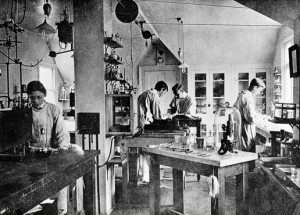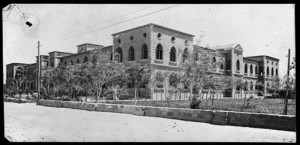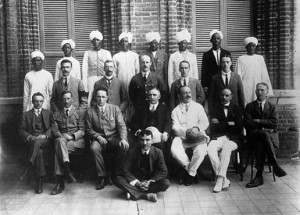Tuberculosis is a bacterium based infectious disease, known as Mycobacterium-tuberculosis. It is a widely held misconception that tuberculosis (TB) is a disease that only affects the lungs. In fact TB can affect any part of the body, both the skeleton and the soft tissue. The key aim here is to identify the various types of TB that affect children and how these affect different parts of the body, with a view to making the patient records and radiographs of the Stannington Sanatorium more understandable.
Primary Infection
Tuberculosis is generally contracted through the inhalation of infected droplets, usually the result of a cough or sneeze, from an individual with active infection. Once inhaled the infection enters the lungs where it manifests itself as a primary complex (Primary TB). Initial infection can be identified by a fever and night sweats which would last up to two weeks, not dissimilar to the effects of pneumonia. This may be followed by skin dullness, weight loss, an increased respiratory rate and haemoptysis (coughing up blood or blood stained sputum). The primary infection goes into a state of incubation during which it multiplies on a small scale to reduce the immune system’s ability to identify its presence, it then spreads throughout the body.
Secondary Infection
There are two ways in which tuberculosis can be disseminated throughout the body, through the lymphatic system and through haematogenous spread (blood stream). The process of widespread dissemination of infection is categorised as miliary tuberculosis, which occurs early in primary infection. It is identified as a series of tiny spots in radiographs, but also causes Chorodial tubercles or pale lesions on the optic nerve which serve as an important symptom in diagnosing this form of TB, particularly in children. Due to its disseminated nature within the body, miliary TB is responsible for a number of other forms of secondary tuberculosis. Organs including the liver, spleen, kidneys, bladder and genitalia are all affected by tuberculosis which are connected to haematogenous miliary TB.
Miliary tuberculosis is also closely linked with the most fatal form of TB, tuberculosis-meningitis. Affecting the central nervous, TB-meningitis has been attributed with a large proportion of tuberculosis related deaths amongst children. It is caused when tuberculosis bacteria infiltrate the fluids surrounding the brain and spinal cord causing small abscesses, which when burst cause tuberculosis-meningitis. It is often identified from symptoms such as irritability, listlessness, headaches and vomiting.
Tuberculosis also manifests itself within the skeletal system. Tuberculosis of the bones and joints is more prevalent in children, and is well represented in the patients of the Stannington Sanatorium. Spinal involvement in tuberculosis, also known as Pott ’s disease, is considered to account for the highest number of skeletal tuberculosis cases. Tuberculosis affects the spine through the destruction of the discs between individual vertebrae and ultimately the collapse of the spinal column causing an identifiable curvature of the spine. The compression or angular result of spinal tuberculosis can proceed to cause paraplegia and/or neurological damage depending on the number and location of the vertebrae involved.
Extra-spinal tuberculosis can be divided into two categories, although they commonly fall under the title ‘bone and joint TB’, the first being tuberculosis-osteomyelitis. The effect of this form of TB is usually characterised by destruction of portions of the long bones and the epiphyses (ends of the long bones), followed by periostitis, the process of new bone growth. In the hands and feet, there is also usually noticeable swelling of the soft tissue in addition to bony anomalies.
The second form of skeletal tuberculosis is tuberculosis-arthritis, which affects the joints, including the hip, knee and elbow. This can be caused by direct invasion from adjoining bones with tuberculosis-osteomyelitis or through miliary TB. Tuberculosis of the joint causes erosion of the joint surface and depletion in the space between the joint. This can subsequently cause septic arthritis of the joint, in which the joint surface is destroyed ultimately causing ankylosis (stiffness and immobility).
Abdominal-tuberculosis is another common extra-pulmonary form of tuberculosis. This was considered a primary form of tuberculosis prior to milk pasteurisation, as individuals could contract the bovine strain of mycobacterium-tuberculosis (mycobacterium-bovis) through the ingestion of contaminated meat or unpasteurised milk. It is characterised by ulcers and thickening of the bowel wall and can lead to the secondary tuberculosis: peritoneal-tuberculosis. Abdominal tuberculosis often healed spontaneously sometimes with calcifications in the abdominal region which act as radiographic evidence of the disease.
Tuberculosis of the pleural cavity, the space found between two layers of pleura surrounding the lung itself, is considered to be a direct complication of primary infection of the lungs. Pleurisy with effusion and empyema are the two most common forms of tuberculosis found within the pleural cavity. Despite the involvement of primary infection within the lungs and the pleural cavity, tuberculosis of the pleural space is considered as an extra-pulmonary form of tuberculosis.
A less common form of TB is tuberculosis of the skin, identifiable by the nodular skin lesions found on the face; the most common form of this is lupus vulgaris.
Finally chronic pulmonary tuberculosis, also known as tertiary, re-infected or adult tuberculosis, where infected bacteria encounter an area already sensitised to the infection. This can occur in children who have had already had primary tuberculosis and usually appears in adolescence and early adulthood.
Stannington Sanatorium
The diagnoses of patients from Stannington Sanatorium display a range of different types of tuberculosis. Pulmonary case files are the most numerous, however these also consist of those patients admitted for non-TB pulmonary conditions such as bronchiectasis. Still once all non-TB patients are removed from the case files, pulmonary or primary TB accounts for a significant proportion of patients treated at the Stannington Sanatorium.
All patients were subject to a chest radiograph upon admission as a diagnostic tool. As a result the radiographic collection holds a predominance of chest radiographs displaying a range of chest related forms of tuberculosis and non-tuberculosis conditions.
Miliary tuberculosis features prominently within the patient files, and is usually associated with those suffering from a severe form of the disease. As an extension of this form of tuberculosis there are also a range of organ, nerve, skin and skeletal related tuberculosis cases.
Stannington also offers a generous proportion of bone and joint tuberculosis allowing for detailed examination of the ways different bones were affected by the infection. This allows for the study of skeletal progression of the disease, particularly useful for comparative purposes when looking at tuberculosis in archaeological collections.
Sources
Meningitis Research Foundation: http://www.meningitis.org/disease-info/types-causes/tb-meningitis
Harisinghani, M.G; McLoud, T.C; Shepard, J.O; Ko, J.P; Shroff, M.M; Mueller, P.R (2000). Tuberculosis from Head to Toe, in Radiographics pp.449-70. http://www.ncbi.nlm.nih.gov/pubmed/10715343




